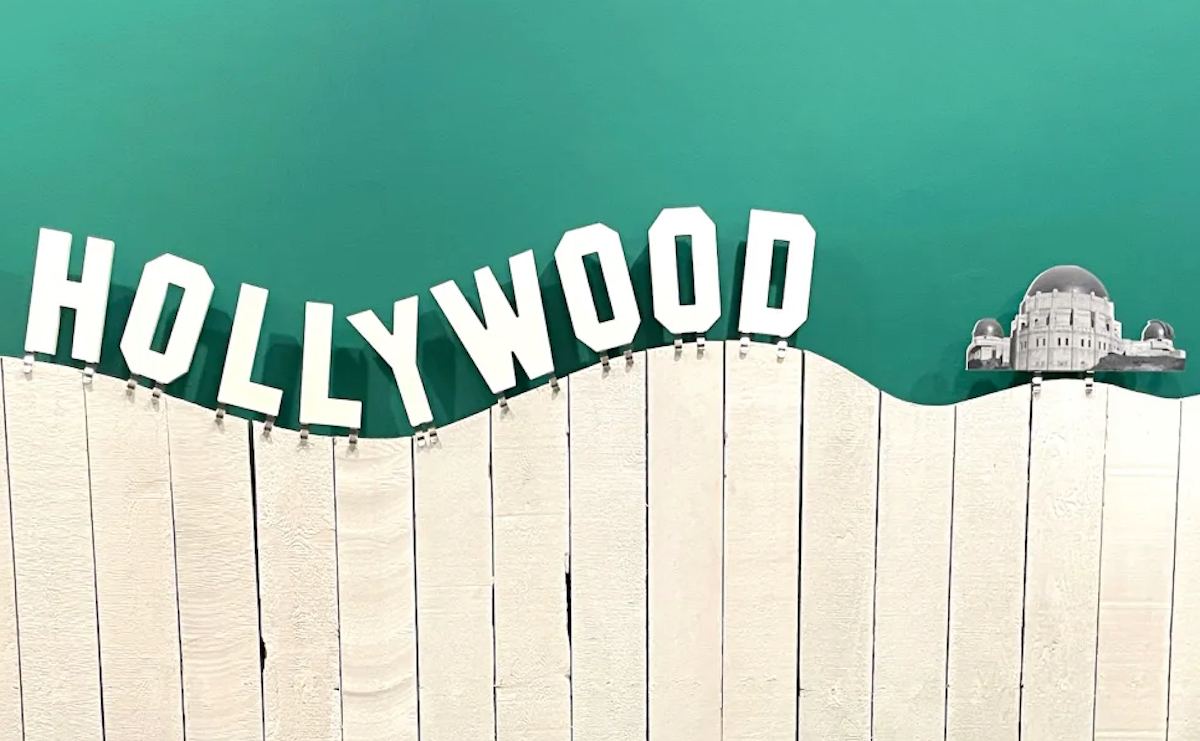LOS ANGELES — As I walked through No Prior Art: Illustrations of Invention at the Los Angeles Public Library’s downtown Central Library, a small installation stopped me dead in my tracks. Through an open door was a jail cell, sparkling in its brand new stainless steel. Squeezed into the narrow room, about the size of my walk-in closet, was a bunk bed, desk, shelving, and toilet mounted mere centimeters away from the bottom bunk.
“Prisoners’ Invention” (2001–14) recreates the room in which an incarcerated inventor, simply known as Angelo, lived for more than a decade. An artist collective on the outside, Temporary Services, built prototypes of the items Angelo saw MacGyvered in the prison system, like salt and pepper shakers made from empty Bic lighters, a pop-up Christmas tree painted on cardboard, and a cigarette lighter fashioned from a paper clip, disposable razor, and styrofoam cup. In this room, Angelo’s voice has been preserved through excerpts from his letters, which accompany the prototypes and patent-like drawings.

No Prior Art, curated by Todd Lerew, showcases the library’s extensive patent collection. Angelo’s gallery is separated from the rest of the exhibition. Because he could not legally file these inventions from the confines of his cell, he technically doesn’t belong here. Yet Lerew felt it was important to platform incarcerated people, who are among the most brilliant inventors in our society.

The overall exhibition celebrates innovators who don’t come from a typical industrial design or engineering background. The library’s patent collection includes plants, and one wall is dedicated to photographs of new fruits and roses amateur horticulturists have grown in their backyards. Another display features patent models from the 19th century — miniature, three-dimensional drafts of side saddles and irons that were once necessary to submit with a patent illustration. A third section highlights quack science, where snake-oil inventions like the “Radium Ore Revigator” (1912) — a radium and uranium-lined jug that supposedly added more energy to water — sit alongside earnest yet misguided early medical devices.
The exhibition juxtaposes these historical objects with contemporary artworks and commissions inspired by patents. For instance, Shervone Neckles’s large, black metal lightbulb sculpture, “BEACON” (2020–21), automatically glows when visitors approach it. Neckles based the work on an illustration for a carbon filament Lewis H. Latimer, an inventor, engineer, and freed slave, developed in 1881. And KAOS Network, artist Ben Caldwell’s media lab, shows off its prototype for an Afrofuturist, driverless car, upholstered in Kente cloth, which Caldwell hopes will cruise through Sankofa City, a community-designed, radically Black urban enclave that he has been building in the Leimert Park neighborhood of LA.
New commissions include an eclectic array of objects by Pippa Garner, who has been sketching quirky, gender-bending items since the 1970s. The library turned a few of her drawings into physical prototypes. They include the “Shu-Haul (shoe trailer)” (1980s–2024). A play on a stereotype of lesbian culture, U-Hauling, is made literal with a miniature truck bed hitched to a brown loafer. Angelenos may also want to get their hands on “The ‘Hollywood Effect’ Fence” (1983–2024), which lets anyone clip miniature versions of the iconic Hollywood sign to their white picket fence.

No Prior Art also allows audiences to become inventors through a series of collaborations with painter Ellen Harvey called The Utopia Machine (2024). Write an invention on a slip of paper and throughout the show’s run Harvey will render it in monochrome acrylic paint on black wood. So far, people have dreamed up an ant-proof cat food bowl, which the artist adorns with hoses to siphon the intruders, and a plastic-sucking ship, where a powerful hose vacuums all the trash out of the ocean.
Harvey’s commission highlights No Prior Art’s thesis: anyone can be a genius. An invention could be lurking in your home at this moment. A broken drawer mended with duct tape and zip ties could be a million dollar idea, or at least earn a home in the library’s patent collection.



No Prior Art: Illustrations of Invention continues at the Los Angeles Public Library’s Central Library location (630 West 5th Street, Downtown, Los Angeles) through May 11, 2025. The exhibition was curated by Todd Lerew.

